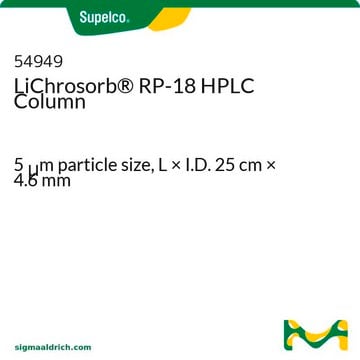1.52023
Chromolith® HighResolution RP-18 endcapped (monolithic) HPLC Columns
L × I.D.150 mm x 4.6 mm HPLC Column
Synonym(s):
Chromolith® HighResolution RP-18 endcapped 150-4.6 HPLC column
About This Item
Recommended Products
product name
Chromolith® HighResolution RP-18 endcapped, L × I.D.150 mm x 4.6 mm HPLC column
material
PEEK column
Quality Level
Agency
suitable for USP L1
product line
Chromolith®
feature
endcapped
endcapped
packaging
1 ea of
extent of labeling
15% Carbon loading
18% Carbon loading
parameter
200 bar pressure
200 bar pressure
45 °C max. temp.
50 °C max. temp.
technique(s)
HPLC: suitable
HPLC: suitable
LC/MS: suitable
mass spectrometry (MS): suitable (High)
mass spectrometry (MS): suitable (High)
column L × I.D.
15 cm × 4.6 mm
surface area
250 m2/g × 250 m2/g
matrix
highly porous
monolithic silica
monolithic silica
matrix active group
C18 bonding phase, octadecylsilane (ODS)
C18 bonding phase
pore size
1.15 μm macroporosity
1.5 μm macroporosity
15 nm mesoporosity
15 nm mesoporosity
operating pH range
2-7.5
2-7.5
separation technique
reversed phase
storage temp.
no temp limit
General description
Chromolith® HighResolution RP-18 endcapped columns have macropores with 1.15 μm diameter, giving a column efficiency exceeding 140,000 plates/meter. The mesopores are 15 nm (150 Å), the surface modification is octadecylsilane with full end-capping.
Chromolith® HighResolution RP-18 endcapped columns fall under the USP L1 Classification. The column efficiency is comparable to a 2.7 to 3 μm particle size fully porous particulate column. Chromolith® HighResolution RP-18 endcapped columns are perfectly suitable for LC-MS applications.
The column dimension of 150 mm length and 4.6 mm I.D. is the best choice for high-resolution separations of complex compound mixtures on any HPLC System.
The revolutionary, monolithic silica with its unique combination of macropores and mesopores enables:
—Rapid separations at very low column back-pressure
—High matrix tolerance, allowing time and cost savings with simplified workflows
—Cost-savings due to extended column lifetimes
—Connection of columns, flow gradients and the use of mobile phases with higher viscosity
The recommended Guard-columns are:
Chromolith® HighResolution RP-18 endcapped 5-4.6 guard cartridges (3 pieces) [1.52025]
with the Chromolith® Guard Cartridge Holder 5 mm x 4.6 mm [1.52032]
The Chromolith® column coupler can be used to significantly increase the separation efficiency of Chromolith® columns by coupling several columns in series (up to 100,000 plates/per column). [1.51467]
Learn more:
Brochure: Race through your Separations on Any System. Chromolith® Monolithic Silica HPLC Columns
All Supelco HPLC Columns, including monolithic Chromolith® columns, are fully compatible to all HPLC and UHPLC Instruments.
Supelco HPLC Products: The Best Choice for Any LC Instrument
Chromolith® HighResolution RP-18 endcapped columns are also available in 2 mm I.D. column dimension for perfect fit to UHPLC and UHPLC-MS needs.
Flyer: UHPLC-like performance - Rapid and Robust at Low Pressure - Chromolith® HighResolution RP-18 endcapped 2 mm I.D. HPLC Columns
Legal Information
Storage Class Code
11 - Combustible Solids
Certificates of Analysis (COA)
Search for Certificates of Analysis (COA) by entering the products Lot/Batch Number. Lot and Batch Numbers can be found on a product’s label following the words ‘Lot’ or ‘Batch’.
Already Own This Product?
Find documentation for the products that you have recently purchased in the Document Library.
Articles
Validated HPLC method (based on Ph. Eur. Monograph 2668) for quantifying catechins and caffeine in decaffeinated green tea using a Chromolith® High Resolution RP-18e column with advantages in terms of backpressure and matrix robustness.
Validated HPLC method (based on Ph. Eur. Monograph 2668) for quantifying catechins and caffeine in decaffeinated green tea using a Chromolith® High Resolution RP-18e column with advantages in terms of backpressure and matrix robustness.
Validated HPLC method (based on Ph. Eur. Monograph 2668) for quantifying catechins and caffeine in decaffeinated green tea using a Chromolith® High Resolution RP-18e column with advantages in terms of backpressure and matrix robustness.
Validated HPLC method (based on Ph. Eur. Monograph 2668) for quantifying catechins and caffeine in decaffeinated green tea using a Chromolith® High Resolution RP-18e column with advantages in terms of backpressure and matrix robustness.
Related Content
Small molecules are ions and compounds of molecular weight typically less than 900 daltons. These compounds can be effectively separated and analyzed by HPLC, UHPLC and LC-MS using mainly silica particles or monolithic stationary phases with a broad range of column chemistries (modifications).
Small molecules are ions and compounds of molecular weight typically less than 900 daltons. These compounds can be effectively separated and analyzed by HPLC, UHPLC and LC-MS using mainly silica particles or monolithic stationary phases with a broad range of column chemistries (modifications).
Small molecules are ions and compounds of molecular weight typically less than 900 daltons. These compounds can be effectively separated and analyzed by HPLC, UHPLC and LC-MS using mainly silica particles or monolithic stationary phases with a broad range of column chemistries (modifications).
Small molecules are ions and compounds of molecular weight typically less than 900 daltons. These compounds can be effectively separated and analyzed by HPLC, UHPLC and LC-MS using mainly silica particles or monolithic stationary phases with a broad range of column chemistries (modifications).
Our team of scientists has experience in all areas of research including Life Science, Material Science, Chemical Synthesis, Chromatography, Analytical and many others.
Contact Technical Service



